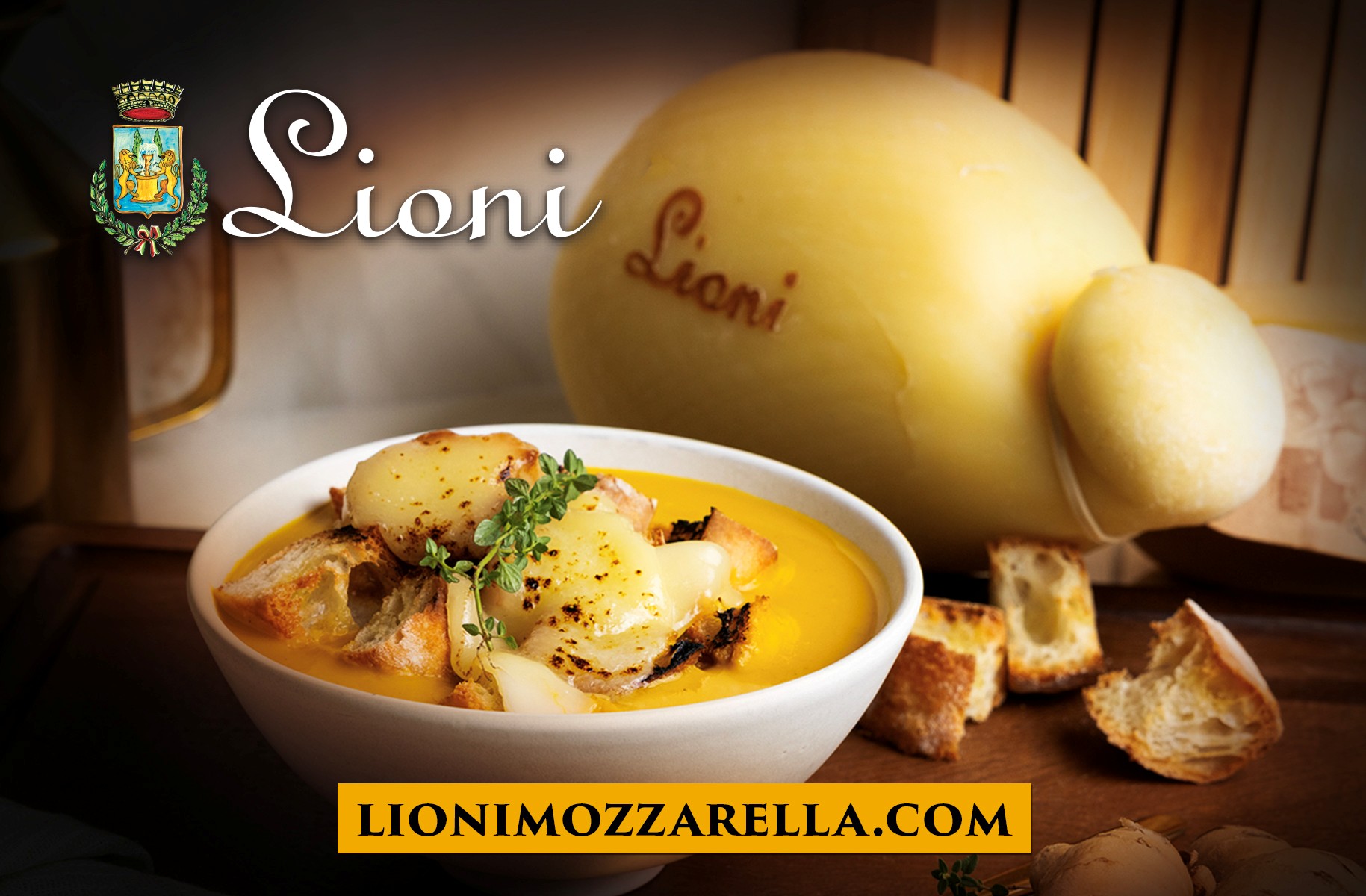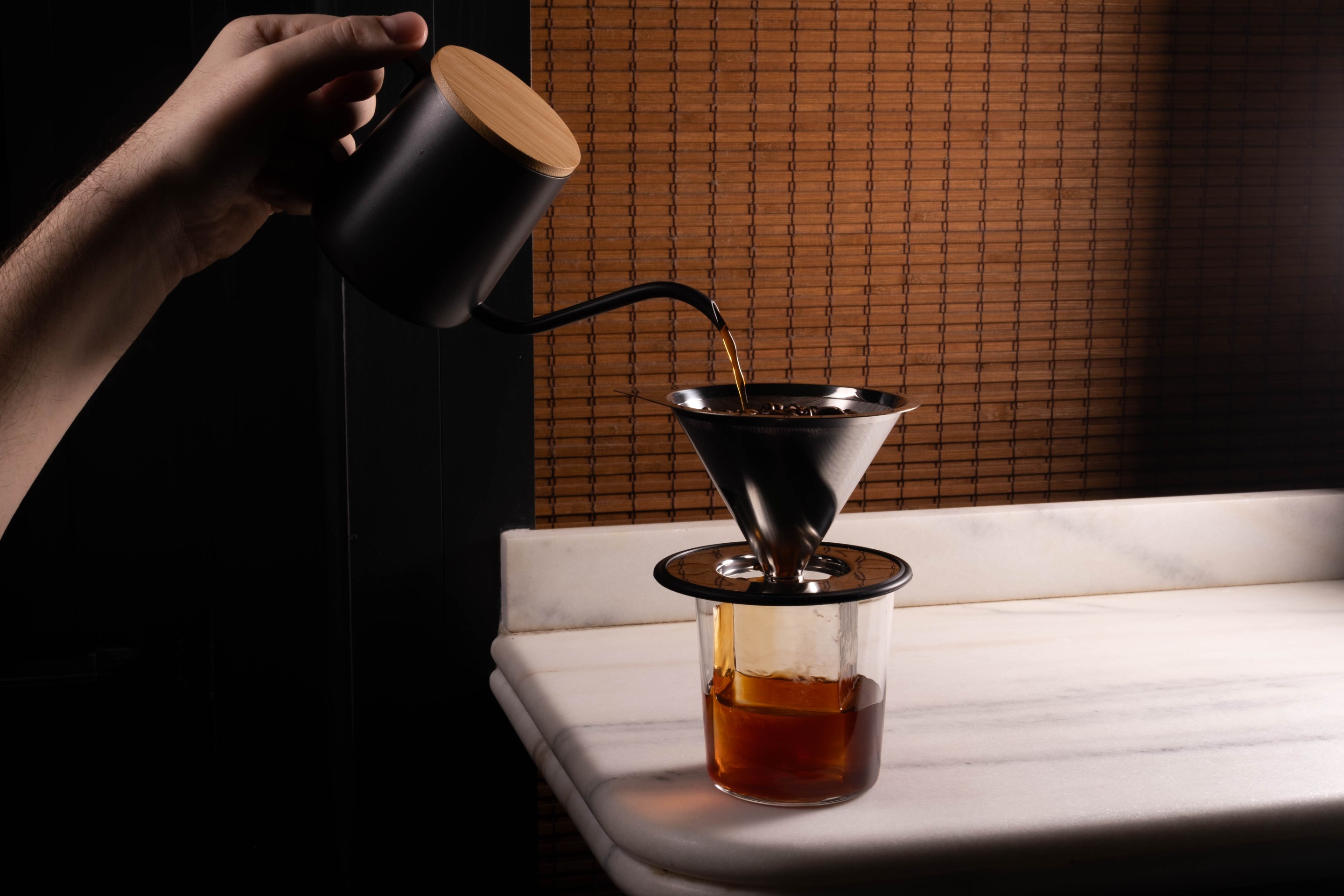I was 21, and he was 18—a young boy with dark, captivating eyes and a smile as radiant as the Sicilian sun. His presence was intoxicating, and I found myself completely smitten. I spent two weeks in the picturesque, sun-drenched Sicilian town of Cassible during the vibrant days of my youth. It was here that I discovered a profound love, not for the charming young man, but for the bittersweet allure of amaro. The enchanting landscape, with its azure waters, rolling hills, and aromatic citrus groves, became the backdrop for my newfound affection.
After our first date, as we finished our pasta, I was given a shot of espresso and a small glass filled with a dark, syrupy liquid that resembled cough syrup in both appearance and taste. I took a sip; it was potent and lingered on my palate, with hints of herbs and licorice. It had a rich texture and countered the bitter taste of the espresso. It stirred within me a curiosity; I had never tasted or experienced anything like it before.
I asked about the drink and learned it was amaro—a bitter, herb-infused digestivo typically sipped after meals to aid digestion, with roots deep in Italian tradition.
There were several more nights of starry-eyed, dreamy flirtations, but I knew my infatuation with the young man was temporary; we lived too far apart, but the drink — I could bring this home with me.
On my last night in town, I enjoyed amaro once more after dinner. However, I soon had to leave the village and travel north to Paris in preparation for my return to the United States. I visited a local liquor store, bought a small bottle, and took that bittersweet elixir with me to cherish the memory of that summer in Sicily.
Throughout the years, I became increasingly obsessed with this after dinner beverage. It was almost impossible to find anything but Campari or Aperol at the time, so I repeatedly traveled back in a persistent search to find other brands, and to understand why this herbal liquor is such a deeply embedded aspect of Italian culture.
After years of research, I have discovered that amaro isn't just a drink, it’s a cultural touchstone, a liquid embodiment of Italy's rich history and traditions, so I set out to talk to experts at some of the most revered institutions in the country.
Venerable Venice, Cocktails Made from Bitters

First stop, Venice. Upon arrival in Venice, after a boat ride to the island, I immediately disembarked and headed to Cafe Florian, in Piazza San Marco, one of Europe's oldest cafes, where I spoke with Mauro Varagnolo, the head bartender
Caffe Florian is steeped in a fascinating history filled with stories of celebrities and old-world luxury, boasting a clientele list dating back to 1720 that includes musical, political, and artistic luminaries.
I took a seat at the bar with Cristiana Rivolta, the Director of Sales and Marketing as we watched Mauro skillfully prepare their renowned aperitivo, the Florian Spritz, as the first order of business.
Mauro, resembling a charming character from a James Bond film, in a white dress shirt, white jacket and red tie, greeted me with a warm smile and explained, “For our spritz, we use Rosso Nardini as the bitter spirit for this drink, because it offers a rounder, more velvety flavor with notes of orange, gentian root, vanilla, and china callisia, and it is crafted in the Veneto region.”
China callisia is a bitter botanical that has been used for centuries in some countries as an herbal remedy. Curious about this product, I asked to see it and he showed me the bottle, pointing out its deeper red hue. Cristiana remarked, “It’s much deeper in color, similar to our red velvet sofas and chairs in the cafe.”
I took a sip and noticed the notes of orange and a refined mouth feel, more elegant than typical bitters used in a classic spritz. It felt velvet, smooth and silky, yet it retained the characteristic bitterness and herbaceous notes of an amaro.
Mauro went on to say that many of the liquors and amari available at Cafe Florian are produced in Venice and the Veneto region. "We strive to back local distillers because their products provide more complex flavors for our cocktails," he explained, “These unique local flavors distinguish this Venetian spot from the numerous renowned bars nearby.” I quickly downed the spritz while munching on potato chips, eagerly anticipating his next alcoholic offering.
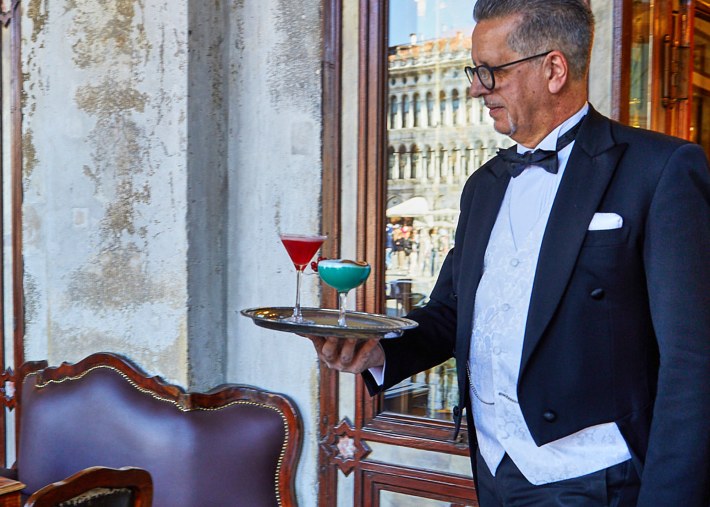
Next up was Italy's renowned cocktail, the Negroni. Mauro poured a jigger of Sospiri Gin, a local Venetian gin featuring hints of juniper and local sea salt, along with 1920 Select and Intrigo Rosso amaro, all crafted in the Veneto region.
I watched, entranced by his precise measuring, pouring, stirring, and the gentle placement of a perfect ice cube into the glass. He strained the exquisite mix into a specially crafted glass featuring the Cafe Florian emblem. As I enjoyed this refined drink, I noticed it perfectly mirrored the sophistication of both the café's salons and its formally dressed waitstaff.
"In Venice, we don't always adhere to the tradition of having a straight amaro post-meal or coffee; instead, we incorporate them into our cocktails," Mauro noted. With a delightful grin, he asked if I was enjoying my Negroni. I took a moment to relish it, my smile revealing my pleasure, and then I asked about the gin.
He passed the bottle to me for a closer look, and right away, I detected a salty aroma. "Ah," he remarked, "that's salicornia," I nodded, recognizing it as samphire. "It grows along our lagoons and gives the typical Negroni a distinctly Venetian twist, it tastes like Venice,” he said as he handed me a small dish with the salt, it had a distinct aroma unlike any sea salt I have had.
As soon as I finished my Negroni, Mauro was already preparing another cocktail. This gesture embodied the essence of Florian, characterized by elegance and hospitality.
After my third drink tasting, I asked about customers ordering straight amaro after coffee, Gaia Bozzo, the first female bartender at Cafe Florian, shared her insights on that question, explaining, "Our younger patrons don't favor straight amari as much, even though we offer the standard Italian brands, so we create innovative drinks inspired by the amari tradition.”
The temptation to linger in such a beautiful environment was overwhelming, but I had to prepare for my next adventure. I left Caffe Florian with the clear impression that cocktails made with amari are as quintessentially Venetian as the lagoon it overlooks.
Tasteful Tuscany
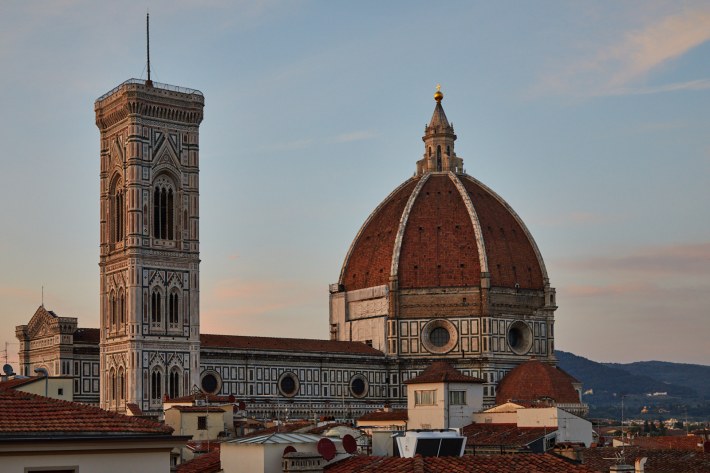
After leaving Venice, I headed south to Florence to meet with Christian Pampo, a lead bartender at the famous Caffe Gilli, my favorite café in Florence. While Venice and Mauro gave off James Bond vibes, Caffe Gilli's polished wood bar, frescoed ceilings, and gilded clock transported me to the elegant world of a Cary Grant film—a perfect snapshot of bygone glamour.
Christian, Grant-like in his demeanor, combined seriousness about amari with quick wit. He poured generous tastings as we discussed Tuscan drinking traditions.
"The true history of amaro," Christian said, "can be traced to the medieval physicians of the La Scuola di Salerno, the medical school of Salerno."
Like many Italian legends and folklore, this story dates back centuries ago when a wounded young man paused at the Arcino Aqueduct to recuperate from some malady. A man named Salernus came across him and treated his wound. Others who were passionate about the healing arts gathered there, marking the school's inception. The school's core principles were rooted in practical, experience-based methods, many involving the use of herbs. In the medieval era, the school played a crucial role in the discovery of distillation, which contributed to the spread of spirits.
As Christian started selecting different amari for me to try, I noticed the excitement in his eyes. "Taddeo Alderotti of Florence was pivotal in recording the history of aqua vitae, as much as I am in the history of amari" he said with a wink. His expression sobered, “Back then, they used the alcohol infused with the herbs to treat disease and many of these concoctions were produced out of monasteries.”
Fascinated by the monastic origins of this drink, I asked if any were still around and he mentioned Abbazia Sant’Antimo in Castelnuovo dell’Abate in southern Tuscany.
Christian arranged a flight of amari before me, many of which I’ve tasted, but he narrated each bottle’s story with the reverence of a historian. He began with Jefferson, with hints of bergamot, rosemary, and oregano, it had a long finish with noticeable herbaceous qualities.
Christian then poured Montenegro—a 130-year old amaro with forty botanicals and a bottle design rooted in alchemical tradition. I’ve had Montenegro several times, but it was the first time I could really linger over a glass. I noticed the spice, bitter qualities, and a hint of floral notes; it was like a complex perfume.
Next came Vecchio del Capo, lighter in color and sweeter than the others. "The younger crowd prefers this one, and Averna," Christian explained. "They want bitter-sweet, not truly bitter like Unicum or Petrus." I typically drink my amari on ice and noticed some amari he poured over ice, while others were served neat. "High-proof spirits benefit from dilution," Christian explained, "but room temperature reveals their true character. He added that Vecchio del Capo markets their amaro to be served frozen, popular with younger drinkers.
I began to feel slightly hallucinatory after three tastings, which might explain their popularity centuries ago—after three drinks, any pain you had would likely vanish. I quickly gulped down a glass of water and ate some nuts, hoping to counter the effect.

After a short break, Christian reached behind the bar for one more, "This one," he remarked with a sly grin, "is something of an experiment." He poured a large tasting into a clean glass and slid it across the bar. It was labeled Sinfonia and I had never heard of it or seen it anywhere. I sipped it, immediately, I could discern the higher alcohol content, with hints of orange and cinnamon, and a coffee-like finish. Christian chuckled at my expression. "Amaro is known as amazza caffè. It kills the coffee."
He didn’t reveal the details of this experiment, but I later learned that it was a proprietary amaro crafted specifically for Caffe Paszkowski, which is the sister café to Gilli.
I finished my tasting, enriched by the history of amaro, the camaraderie of standing in an Italian bar, and the making of new friends.
On the way back to my hotel, I picked up a bottle of Amaro Morelli—"I liquori dei Miracoli," printed on the bottle--the miraculous liquor. That evening, I poured a small glass and had a sip. The amber liquid revealed notes of caramel and licorice, perfectly balanced. No miracle. Pure pleasure. Tomorrow: the monastery.
The next day, I picked up my rental car and drove south along the cypress-lined roads of Tuscany to Abbazia di Sant’Antimo, the legendary monastery south of Montalcino near the Val D’Orcia.
Monastery Miracles

Legend has it, that Charlemagne founded this abbey in 781 AD, as he and his soldiers found refuge here during the plague, where the monks prepared and provided herbal remedies for them, including miraculous tonics.
The monastery stands as it did then, gardens remain abundant with flowers and herbs, so during my visit, I strolled through them before heading to the monastic pharmacy, where they continue to sell their proprietary amari. Though production has moved beyond the monastery walls, the recipes remain relatively unchanged since medieval times.
I bought two bottles of amari: amaro rabarbaro and amaro carlina. The rabarbaro itself has an alcohol content of 27%, which I imagine would have been quite potent for treating ailments during Charlemagne's time. This amaro features rhubarb notes, which are reflected in its name. The use of rhubarb in tonics is a long-standing tradition in Italian convents as rhubarb has known health benefits.
After making my purchases, I stepped into the abbey, awed by this sacred place and imagined the lives of the monks who lived here, who for centuries had an influence on amaro production.
South to Sicily, Land of Sun-kissed Oranges

Sicily has a special place in my heart. I have many treasured memories of youth and a carefree life from my first visit, so I was eager to travel back to this region to discover the differences between traditional Sicilian amari and those of central and northern Italy.
I left Tuscany, hopped on a flight and landed in Palermo. From there, I headed to Buatta Cucina Popolana in the historic district of Palermo, where I met with another respected bartender, Umberto de Simone. Umberto was like the actor Jimmy Stewart, quiet in his demeanor, easygoing, yet passionate about the subject of Sicilian amari.
He quietly led me to the rear of the restaurant where the bar is, and we sat in a corner. As he brought four bottles to the table, I noticed that the bottles had more distinctive shapes and bolder typography than the usual offerings like Averno, Montenegro and Cynar, likely aimed at attracting a younger, trendier crowd of amaro enthusiasts.
After examining the labels and inquiring about their origins, Umberto explained, “These amari showcase our local oranges, and lemons, the citrus of Sicily, in addition to the traditional use of herbs.” The first one he selected for me to taste was Amaro Amara Rossa. As he was pouring a glass, he went on to say, “The red oranges in this one are harvested from the volcanic slopes around Mount Etna, a specialty of our region.”
I lifted the glass to try my first sip, and a vibrant burst of red orange was the top note on my palate. I hesitated to choose favorites, but I couldn't help but think that this amaro was truly sublime, surpassing all the others I had tasted so far.
Continuing the tasting, he introduced me to the Jacli brands, which originate from Palermo and specialize in producing amaro and limoncello. Their Cartasio is an amber spirit featuring the local bitter orange peel, technically with the bitterness it can be classified as an amaro, some might debate the classification, but at 33% alcohol content, the semantics seemed far less important than the experience itself.
Umberto explained that Cartasio is best enjoyed chilled, with a large ice cube to maintain its potency, so he poured a small glass over a large cube for me to taste. Being a fan of bitter citrus, I found this one irresistible and asked where to buy it. “Across the street,” he said beaming.
Jacli's other offering, Burtuqa, features orange peel with a proprietary blend of aromatic spices. Though labeled a liqueur, its bittersweet complexity places it firmly in amaro territory. I couldn't help but notice how Sicily's distillers were pushing the boundaries of what amari could be, blending tradition with bold new approaches.
Our final bottle was Monte Polizo, a brand originating from Salemi on Sicily's western coast. It offered a rich mix of flavors, featuring the renowned Sicilian oranges and over 30 spices from across the world, including star anise, vanilla, cinnamon, and cardamom.
He poured a shot into a tiny glass. I sipped. Dense. Lush. This amaro revealed itself like a literary masterpiece—each sip uncovering new layers, bitter yet balanced, each taste demanded the same patient attention one might give to a Tolstoy novel, with flavors that would take multiple encounters to fully comprehend.
I love long novels, especially of a classical nature--I’d have to buy a bottle of this as well, to really understand it. I was beginning to wonder if I should buy an additional suitcase.
After sampling such a diverse array of amari, from centuries-old monastery recipes to modern Sicilian innovations, I felt a sense of temporary contentment —as if I'd conquered an ancient Italian tradition. Yet even as I closed this chapter of my tasting journey, I knew the affair wasn't truly over. Somewhere in Italy, another new brand and undiscovered bottle waited, promising another tasting I had yet to experience.
For those eager to trace this journey themselves, here are a few places—and a few recipes—to begin.
If you go:
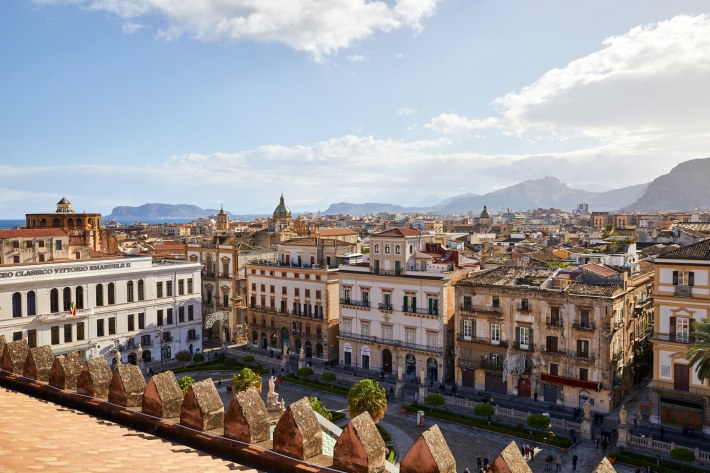
- Caffe Florian, Piazza San Marco 57, Venezia, IT 30124
- Caffe Gilli, Piazza della Repubblica 39R, Firenze, IT 50123
- Abbazia Sant’Antimo, Localita' S. Antimo, 222, Castelnuovo dell'Abate, IT 53024
- Buatta Cucina Popolana, Via Vittorio Emanuele 176, Palermo, IT 90133
Amaro Cocktail Recipes, Courtesy of Caffe Florian
Baccio Veneziano – an homage to Venice
- 1.5 ounces bourbon
- 3 ounces Intrigo rosso vermouth (or similar)
- Splash of bitters
- Combine all in a cocktail shaker with ice, shake well and strain in a martini glass, garnish with edible gold glitter dust.
Red Sighs – aromatic herbs and spices from the East
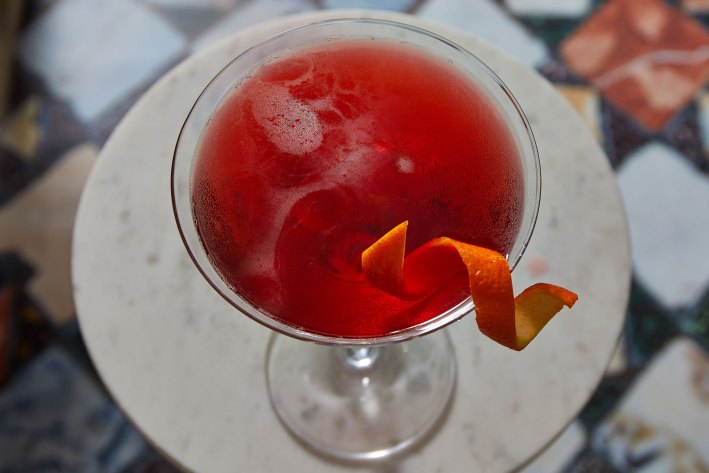
- 1 ounce Sospiri Gin (or gin of choice)
- 1 ounce Orange Pekoe Tea
- 2 ounces Select Apertivo (or Campari)
- Combine all in a cocktail shaker with ice, shake well and strain in a martini glass, garnish with an orange peel.

